
Finding the best assisted living facility is important for seniors who need daily support while maintaining their independence. A good facility provides personal care, meals, activities, and medical assistance in a safe and comfortable setting. Choosing the right place requires research, visits, and careful evaluation of services. This guide will help you understand what assisted living is, how to find a good facility near you, and what factors to consider when making a decision.
Assisted living is designed for seniors who need help with daily tasks such as bathing, dressing, medication management, and meal preparation. Unlike nursing homes, which provide full-time medical care, assisted living focuses on personal care and social engagement. Residents live in private or shared apartments, have access to dining services, participate in activities, and receive assistance as needed.
Many seniors move to assisted living when living alone becomes difficult. Common reasons include mobility challenges, memory issues, or the need for social interaction. The goal of assisted living is to provide support without taking away a person’s independence.
To find the best assisted living facility, start by listing personal needs and preferences. Some people need minimal help, while others require specialized services like memory care for dementia. Consider the level of care needed and look for facilities that match those requirements.
The next step is setting a budget. Assisted living costs vary based on location, amenities, and services. The average cost in the U.S. ranges from $2,000 to $8,000 per month, depending on the facility. Some seniors pay with personal savings, long-term care insurance, or Medicaid, depending on eligibility.
Once you have a budget, start searching for facilities in your area. You can use search engines or senior care websites to find options near you.
Evaluating Assisted Living Facilities
When comparing assisted living facilities, visit in person to see the environment. A clean, well-maintained facility with friendly staff is a good sign. Observe how caregivers interact with residents. Are they patient and attentive? Do residents seem happy and engaged?
Ask questions about services, costs, and daily life in the facility. Some important topics to discuss include:
Also, pay attention to dining options. Meals should be nutritious, well-balanced, and appealing. Some facilities allow residents to choose from different meal options, while others provide set menus. Good nutrition is essential for seniors, so food quality matters.
A good assisted living facility should provide a safe, comfortable, and welcoming environment. Private or shared apartments should be spacious, clean, and equipped with safety features such as grab bars and emergency call buttons. Common areas should be inviting and encourage social interaction.
Social activities play a big role in assisted living communities. Seniors who stay engaged with hobbies and group activities tend to be happier and healthier. The best facilities offer exercise classes, arts and crafts, game nights, music events, and outings to local attractions.
Reliable transportation is also important. Many seniors no longer drive, so they need transportation for doctor visits, grocery shopping, and recreational trips. Some facilities provide scheduled transportation services, while others offer on-demand rides.
Even though assisted living is not a medical facility, some residents need help managing their health. Many communities offer medication management, on-site nurse visits, and wellness programs. If a resident needs regular medical attention, choose a facility with healthcare support.
Safety is another key factor. Assisted living communities should have secure entry points, 24/7 emergency response systems, and trained staff available at all times. Falls are a common concern for seniors, so look for facilities with non-slip floors, handrails, and good lighting in hallways and bathrooms.
A well-chosen assisted living facility improves a senior’s quality of life. Residents receive the help they need while enjoying social opportunities, safety, and comfort. Families also gain peace of mind, knowing their loved ones are in a supportive environment with professional caregivers.
Moving to assisted living can reduce loneliness and provide a sense of community. Many seniors form new friendships and participate in activities they might not have access to while living alone. The structured environment helps maintain physical and mental well-being.
Additionally, assisted living relieves family members from the stress of caregiving. Many families struggle to provide full-time care for aging relatives. Assisted living ensures seniors receive proper support while allowing family members to focus on their own responsibilities.
Some people hesitate to consider assisted living because of misconceptions. One common myth is that moving to assisted living means losing independence. In reality, assisted living allows seniors to remain independent while receiving the help they need. Residents can make their own schedules, participate in activities they enjoy, and decorate their living spaces as they wish.
Another misconception is that assisted living is too expensive. While costs vary, many financial assistance options exist. Medicaid may cover assisted living for eligible seniors, and some long-term care insurance policies help pay for services. Veterans may also qualify for financial aid through VA benefits.
Some people worry that food in assisted living is bland or unhealthy. In fact, many facilities provide high-quality, restaurant-style meals designed by dietitians. Seniors can choose from a variety of meal options, and special diets are often accommodated.
After researching and visiting several facilities, compare options based on services, comfort, and cost. Read the contract carefully before making a commitment. Understand what is included in the monthly fee and whether there are additional costs for extra services.
If possible, spend a trial day at the facility before making a final decision. Some communities offer short-term stays, allowing seniors to experience daily life before committing to a permanent move.
Choosing an assisted living facility is a big decision, but taking the time to research and visit different communities helps ensure the best choice. The right facility provides a safe, comfortable, and engaging environment where seniors can enjoy their later years with dignity and support.